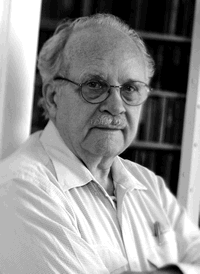The opening of David Madden’s eleventh novel sets the stage for the dramatic series of interwoven stories that follows. The tale begins in 1665, the year of the great plague, and illuminates the story of Old London Bridge, which was designed by an architect-priest, Peter de Colechurch, and began construction in 1176. Eventually dismantled in 1834, the bridge, replete with stores and houses, was long considered one of the wonders of the world. London Bridge in Plague and Fire tells the story of the bridge and two of the calamities that afflicted its inhabitants. In the book, London Bridge serves as the story’s backdrop and acts as a dominating force in the lives of the principal characters.
In this meticulously researched, wildly imagined tale, the setting is the star of the show: “This Bridge stretched before us—on its twenty piers and arches—is supporting 138 shops, each with a three-to-six-storey house above it, the tallest bridge in England, and eight hundred inhabitants,” Madden writes. “Quite sick, but not fatally ill, she stands still, in defiance of over two thousand years, time told by sundial, hourglass, and clock, for all of the bridges built at this site over the past are one London Bridge. Chronicled assaults of tides, gale, frost, flood, foreign and domestic bombardment, and the very tension and stress of its own structure fulfilling its function, have taken their toll, aggravated by human and mercantile traffic and royal, municipal, and ecclesiastical neglect.”
Lloyd Baintree, unofficial record-keeper for London Bridge, plans to pass on to his young son, a poet named Daryl, the stewardship of the “Chronicles of London Bridge,” an ancient logbook which has been handed down in secrecy from generation to generation. Daryl scoffs at the offer, uninterested in recording merely “facts without fancy.” Lloyd, noting that “This noble task is not for a drunken, whoring, irreligious, cursing young poet,” resolves instead to leave the chronicle in the care of a young bridge dweller named Morgan Wood, who has loved the bridge since he first set foot on it. At the time of Lloyd’s death in 1665, however, Morgan is away at sea, where for seven years he’s been working off his father’s debt to a goldsmith, Clinkenbeard. Daryl appoints himself the new keeper of the chronicle, despite his father’s pronouncement.
 The main obstacle Daryl faces in his new task is finding the chronicle itself. The self-appointed Poet-Chronicler turns inside out his family’s home on the bridge, Nonesuch House, with no results. Lacking any documents, he decides to re-imagine the bridge’s history, beginning with its architect. Daryl’s fabricated entries into this new record—including his own poems, visions of Thomas Becket and Peter de Colechurch, and conversations about the bridge with this mistress, Musetta—are threaded throughout the novel.
The main obstacle Daryl faces in his new task is finding the chronicle itself. The self-appointed Poet-Chronicler turns inside out his family’s home on the bridge, Nonesuch House, with no results. Lacking any documents, he decides to re-imagine the bridge’s history, beginning with its architect. Daryl’s fabricated entries into this new record—including his own poems, visions of Thomas Becket and Peter de Colechurch, and conversations about the bridge with this mistress, Musetta—are threaded throughout the novel.
At sea and dreaming of returning to the bridge, Morgan meanwhile keeps a journal of his longings for home. Morgan is the victim of repeated acts of sadism inflicted by Lucien Reed. During the civil war between “Puritans and Royalists, Roundheads and Cavaliers,” Lucien was viciously raped and beaten by soldiers on both sides. The experience released his own inner evil, and he claims to have baptized himself as Lucifer’s orphan.
After London’s plague of 1665 and the great fire the following year, a group of the bridge’s merchants, led by Clinkenbeard, band together out of fear that God’s wrath will next be inflicted on the bridge. The men hatch a plan to carry out an old pagan ritual and have chosen one of their own daughters, Blythe, only thirteen, to be buried alive in a pier on the bridge. They hire Lucien, who has returned from sea with plans to destroy the bridge himself, to kidnap Blythe and leave her in the pier. When Morgan arrives back home and joins the search for her, the fate of the bridge and the people who call it home hang in the balance.
David Madden is a Knoxville native and University of Tennessee graduate who has written novels, plays, poems, essays, and literary criticism. His best-known work, The Suicide’s Wife, was nominated for the Pulitzer Prize. During the three decades he spent preparing to write this novel, Madden read hundreds of related books. His prodigious research—and his boundless imagination and curiosity—are evident throughout. For readers interested in historical fiction, London Bridge in Plague and Fire stands out for its multi-dimensional plot, dynamic wordplay, and richly nuanced characters. The book is a treasure trove of entertainment and suspense.
As part of the “Writers in the Library” series, David Madden will read from London Bridge in Plague and Fire on November 12 at 7 p.m. in the Hodges Library Auditorium on the Knoxville campus of the University of Tennessee. This free public event, part of the “Writers in the Library” series, is co-sponsored by the UT Creative Writing Program.
Tagged: Fiction





